(Click on any image below for a larger view or take a virtual tour of the Bread Lab here.)
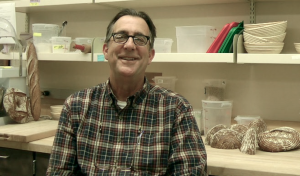
Walk past any college laboratory and you could probably identify the subject at hand by the smell. The chemistry lab reeks of chlorine and sulfur, the biology lab sends off whiffs of formaldehyde, and even the botany lab smells earthy, fruity, and sometimes sweet. But never have such wonderful odors come from a lab until you pass something called the Bread Lab!
A cross between all three – the chemistry, biology, botany labs – the Bread Lab at Washington State University, Mount Vernon, is the culmination of a dream for Dr. Stephen Jones, plant breeder and professor.
One of a Kind
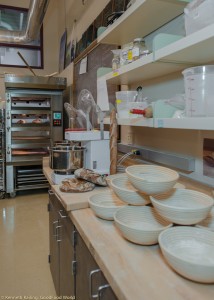
The few “Bread – or Grain – Labs” located across the country have been developed by the USDA, which has regional labs, or large millers or bread manufacturers. The USDA, for example, maintains the Western Wheat Quality Laboratory at WSU Pullman WA where the testing that takes place is similar to that which the Mount Vernon Bread Lab performs. The key difference? The Bread Lab focuses on grain for use in bread baking, and it is open to grain growers, small millers, craft bakers, and serious home bakers.
“We don’t do high volume commercial wheat and we don’t do plastic-wrapped bread – that makes us unique,” says Jones. “Everything we do is for craft bakers, craft farmers, and small millers. We’re completely off the commodity grid!”
In one sense, Jones is a purist, in others he is not. For example, the Bread Lab makes only 100% whole grain breads, no white flour added, from four ingredients: flour, water, salt, and wild yeast starter. And of course, time.
While he is partial to organic grain, Jones is not one to shut the door on conventionally grown wheat. He has one criterion though: the grain should not be treated with insecticide during storage.
Knowing that local grains, even conventional grains, have not been dusted with pesticides is a food safety issue that Jones is adamant about. Grain is one of the few foodstuffs that are not washed or otherwise cleaned of chemicals during processing, and those chemicals remain in the food you eat.
Wheat in Western Washington
True, most of us think of the northern Great Plains as the “Bread Basket” of the country, the place where our wheat comes from. And because the climate there is so very different from that of Puget Sound, modern consumers are firm in their belief that wheat couldn’t grow here. Nothing could be farther from the truth!
In the mid-1800s, the map of wheat production looked very different than it does today. Most of our wheat came from the eastern half of the US and the Pacific Coast states were major producers.
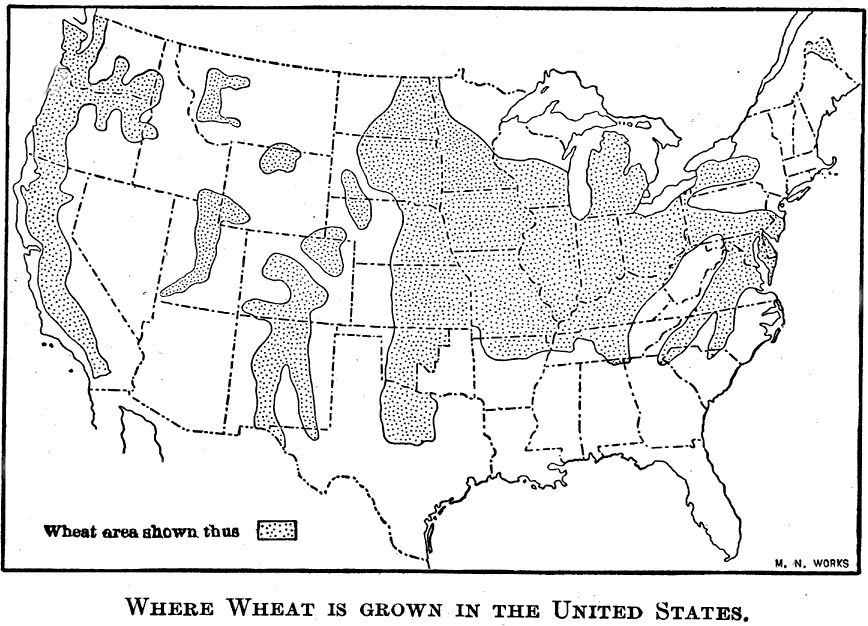
In 2011, the map looked very different. Production had moved east from the Pacific Coast and west from the Midwest and eastern states to the central and northern Great Plains. The large section of wheat growers in western Washington virtually disappeared.
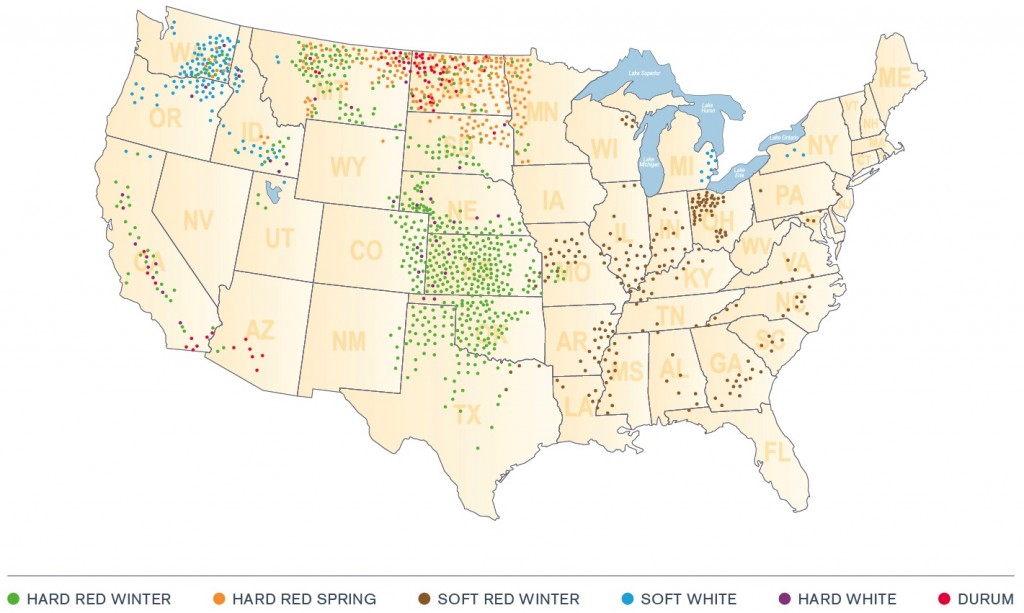
And as the wheat growers vanished, the millers followed them. In the late 19th century, there were nearly 160 flour mills in the state of Washington; more than 22,500 across the US. As the railroad network grew, it became easier to ship grain to mills and flour to cities. Today there are only about 200 flour mills spread across the entire country, most in the eastern half. Cargill, ADM (Archer Daniels Midland), and ConAgra alone control more than half of all milling capacity in the US.
By reconnecting the broken links between local and regional grain farmers, the grain cleaners and millers who process their harvest, and the craft and artisan bakers who make it into loaves, we can take back our daily bread. In western Washington we are seeing more organic farmers growing grain as part of their crop rotation, more millers who grind the grain to flour, and more more skilled artisan bakers turning out dense, nutrient-rich breads. The Bread Lab is more than a research facility, it is a group seeking out and reconnecting those broken links.
Testing and Discovery
Mission statements, like this one for the Bread Lab, often express lofty concepts and ideals:
The Bread Lab is a think tank and testing and demonstration laboratory for craft baking. Bakers can use the laboratory to test flours and techniques using local, regional, and nationally available commercial and experimental flours and wheats of all types. The goal is to combine science, art, curiosity, and innovation to explore ways of using local and unique grains in order to move the craft of bread baking forward.
That said, the real purpose of the lab is testing and discovery, according to Jones.
Regular baking days – “bakes” – are now mostly spent testing grains for their performance in bread baking. The week we visited the lab, Jones and his new full-time baker were testing grain varieties from a breeder who is raising wheat in England and New Zealand. The breeder believes that his varieties will grow in the cooler, moister climate of Western Washington. Jones is also testing flour made from different wheat varieties from several mills, including one located in Maine.
The real question is this: will they make good bread? By constraining the variables to just flour, salt, water and starter, it is possible to accurately compare the final loaves. Any variation in flavor or performance will be caused by the wheat, not the baker or the process.
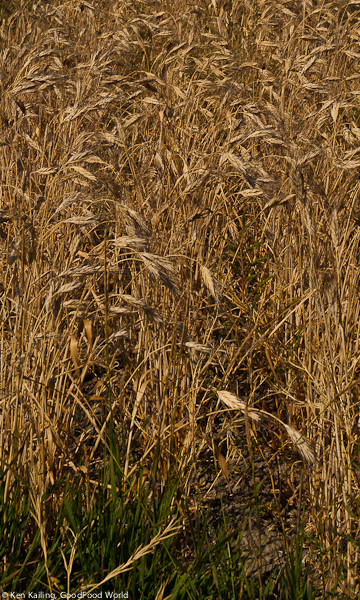
During the discovery activities, Steve is trying to identify the flavors produced by various flours, experimenting with blends to develop those flavors and the flour’s performance, and creating baking techniques for different types of breads.
“We’re breeders too, and we’re developing our own wheat varieties,” says Jones. “We want to make sure that there is a fit for our wheat – a place to market it. It may be a unique niche or it may be a standard process.”
The Lab is working with Fairhaven Organic Flour Mill to develop an exclusive series of recipes and formulas for the flours that Kevin Christenson mills. These recipes will showcase the “best use” of his products and he can give them to craft bakers and serious home bakers to make the best bread out of his flour.
A bakery is a busy place – often in action long before dawn – and a craft baker must have some measure of consistency in the flour he or she buys for bread making. Predictability and consistency are the keys to satisfying a loyal customer base and grains from different farmers and different locations may have very different profiles.
The protein and moisture may vary, the strength and elasticity of the gluten can be different, and the nutritive values may change. To maintain consistency requires blending grains to certain specifications, and small mills simply don’t have the ability to do that.
The Bread Lab will work directly with regional bakers to understand what specifications will result in the kind of flour they need to produce a predictable result. It’s almost like a small winery blending a variety of grapes to produce a certain table wine. And with those specifications, the Lab will help small millers to achieve the product consistency bakers need.
Teaching Facility
Yes, a university IS a teaching facility! After all, the main purpose is education. But the Bread Lab has a slightly different twist, so to speak. It is not a lab that teaches students to make bread, but it serves a dual research purpose for students and bread makers. Says Jones, “I teach genetics, I don’t teach bread baking.” His graduate students will use the lab as part of their breeding research to learn how to identify – and bake with – good wheat.
A much wider audience will take advantage of the lab as a teaching facility in a different way. For example, two area pizza companies are looking to use more local flour in their doughs, and they are analyzing their current flour and dough to understand what targets they will need to meet with local grains. The Lab will be holding workshops for craft bakers, serious home bakers, and wholesalers like King Arthur flour, to learn more about local wheat and how best to use it.
Terroir is Out, Liveliness is In
No, we’re not saying that knowing and appreciating the “terroir” of our food – the unique flavors and aromas that come from our local soil, climate, and other environmental conditions – is no longer important. “The story is over,” says Steve Jones. “We know our unique growing conditions really add flavor to our grains, but we have since discovered there is a liveliness there too.”
When talking about “liveliness” in grains and bread, we mean the ability of the flour to sustain and support the yeasts that are used as leavening. Conventional commodity flour sold in the supermarket comes from grain that has been dried under high heat, stored for long periods usually after being dusted with insecticide to prevent pest damage, and milled into white flour that is then bleached. In comparison, local grains – particularly those that are organically grown – are generally dried and cleaned on the farm, travel short distances and are stored for shorter periods without insecticides, and milled to order into whole grain flour.
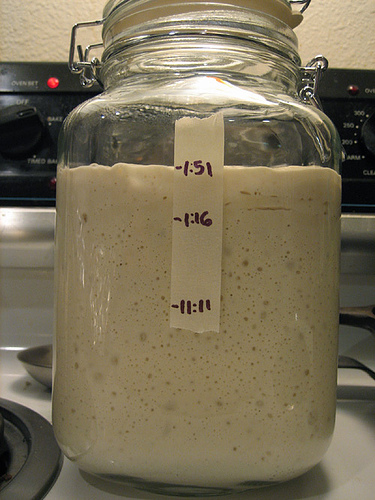
Making a wild yeast levain – also called a starter or sourdough starter – is often considered to be a long and complicated process complete with exacting measurement and frequent feedings. Most instructions allow for 7 days to make a “mature” and active starter. At the Bread Lab, Steve has had a very different experience.
“I put together a starter last Friday,” he said, “and it was alive and growing in just 24 hours! We milled the flour in the morning, and I started it in the afternoon. I’ve never had one that grew so fast. By the end of three days, it looked like it was going to fill the room – it would have started to eat all the flour in the lab and blown off the roof!”
You can do your own experiment to test your flour. Make two starters – one with a commercial brand of whole wheat flour and one with a locally grown flour milled on demand. We recommend you follow the method in Flour, Water, Salt, Yeast by Ken Forkish.
In Puget Sound, Fairhaven Organic Flour Mill only mills flour once the supermarket has placed an order, so it’s days old rather than weeks or months old when you get it. In Oregon, Camas Country Flour Mill also grinds flour once it has been ordered.
You’ll find that a local, organic, freshly-milled flour will give you a strong – and lively – starter in about 5 days. And no need for fruit, juices, or fancy powders – just flour, water, and fresh air! Chances are your second starter will still be languishing with just a few bubbles at the end of a week. Toss it out!
Taking Back Our Daily Bread
Heavy, rich, and nutritious bread was once a daily staple; today commercial industrialized bread, produced in fully automated factories, is full of chemical additives and preservatives and too much salt, and has too little nutritive value.
By reconnecting the broken links between local and regional grain farmers, the grain cleaners and millers who process their harvest, and the home and commercial bakers who make it into loaves, we can take back our daily bread. It is not enough to have farmers growing grain as part of their crop rotation, skilled millers who grind the grain to flour, and artisan bakers turning out dense, nutrient-rich breads, we have to get good whole wheat bread in the hands of consumers.
What can you do?
Eat whole grains and artisan bread. Seek out small local and regional grain growers and millers. Buy a small mill and grind your own. Celebrate your daily bread!
____________________________________________
Read More
Flour Water Salt Yeast by Ken Forkish
Local Grains: Taking Back Our Wheat
Reclaiming Farmland and an Ancient Grain
On the Road: Emmer – An Ancient Grain
Dryland Farmers – Eastern Washington and Northwestern Montana
How to Buy a Flour Mill: Check Craig’s List
On the Road: Historic Grist Mill, Thorp WA
Country Living Grain Mills: One Small Company’s Local Food Economy
When Did Our Daily Bread Take a Wrong Turn?
Tall Grass Bakery: Let Them Eat Bread

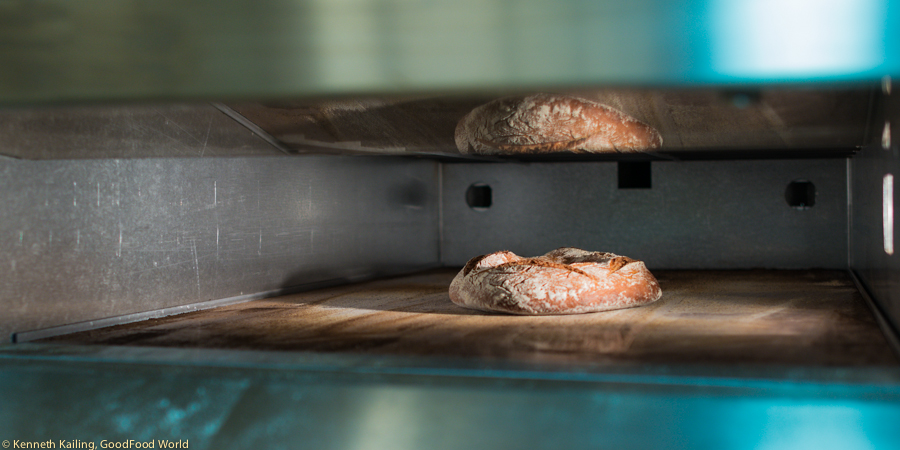
It could be a problem with fermentable sugars in wheat (specifically, oligosaccharides). The applicable acronym is FODMAPS. A gastroenterologist gave me a list of foods that are more or less problematic. The list suggested replacing wheat with spelt. I’ve done it and found it helpful. My local food coop has white and whole grain in bulk, and I can’t yell the difference in baking.
I think the basic problem is one’s gut flora, but I haven’t found a science based way to fix that.
Good luck!
Nice article. We are in exciting times in bread baking. After diving into books by Peter Rhienhart, Daniel Leader and of course Chad Robertson, whole grains and milling ones own flour really makes a difference in taste and health.
We offer bread proofing baskets and grain mills on our site (http://shop.fgpizza.com/page52.html) if anyone is interested. I personally use the PK1 mode grain milll. It’s quiet, effective, and keeps the flour cool while stone milling.
I hope to visit bread lab some day. Sounds fun.
*Edit* When I say forefathers, I don’t mean back to the ice age – I mean my Grandparents and Great Grandparents [SMILE] – X
Xania,
You ask a very good question, and there are some growers who are trying to find an answer.
I believe that the wheat we eat today has been hybridized with two things in mind: increased production and gluten development that makes nice white fluffy bread.
As a result flavor and nutrients have been bred out and there is the likelihood the gluten has changed as well.
That said, man has been selecting wheat (and other grain) for preferred traits for somewhere around 10,000 years – since the beginning of agriculture and domesticated crops.
I’m not a doctor and cannot diagnose wheat allergies, however if I were you, I would get the appropriate blood tests to determine if you do have a wheat allergy.
The true “ancient” wheats are spelt, emmer, and einkorn – all of which can be used to make bread, though I’ve been told they are hard to handle because the gluten isn’t strong enough to take much handling. They ARE forms of wheat and people with Ciliac disease have to avoid them too.
I have been baking with organic flour from grain grown in Washington but it isn’t likely that they are truly “heirloom” grains.
If you are on the East Coast, you may want to reach out to the Heritage Grain Conservancy (http://growseed.org/), or if you’re in California, try the Whole Grain Connection (http://www.sustainablegrains.org).
If you are in the Pacific Northwest, you could contact Steve Jones directly at WSU to find a source for grain in Washington. Otherwise, it’s pretty tough.
Best of luck and keep in touch!
Gail N-K
Co-Publisher
GoodFood World
hello – I have a question that you may or may not be able to answer – but I am posting anyway, looking for some answers…
I am a child of the 60s(the reason I tell you this will become relevant in a moment). I was born in Kansas – family were Wheat farmers… raised on baked goods – the rule was – up at 4am to bake homemade breads, cakes, cinnamon rolls, butter rolls, etc… I grew up on this stuff – and was healthy…
Now – every time I eat wheat ‘flour’ – I get sick – not upset stomach kind of sick – but kind of a allergic reaction – look like I’m 8 mo pregnant weight gain but it’s only water bloat – inflammation of the joints and even what I think is gout and have a hard time walking…
in saying this – I grew up on a wheat producing farm and the only thing that has changed in the 40+ years I’ve been alive – is the wheat… our farm used to use it’s own wheat to replant – and apparently ‘that’s not allowed’ and hasn’t been for some time now… I hate trying to bake/cook/bread meat with almond flour, coconut flour and even zucchini flour… They do not make good baked goods/food and if someone told you that they did, I would bet the farm that they are lying! lol… [SMILE]…
I guess I am asking – are you making breads with the ‘old’ type of wheat? and if you are, how can I get some of the heirloom wheat? BTW, I have already tried Spelt and the other wholegrain wheats on every market – been down that road and it doesn’t work. I’m hoping someone is bringing bake non-adulterated, organic wheat like our forefathers so hopefully people can be well again… Thanks for your time – and I look forward to hearing from you – X